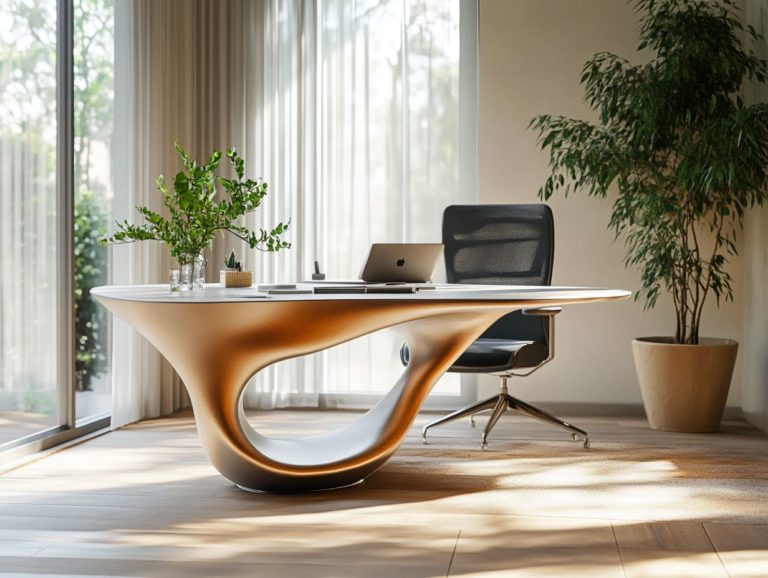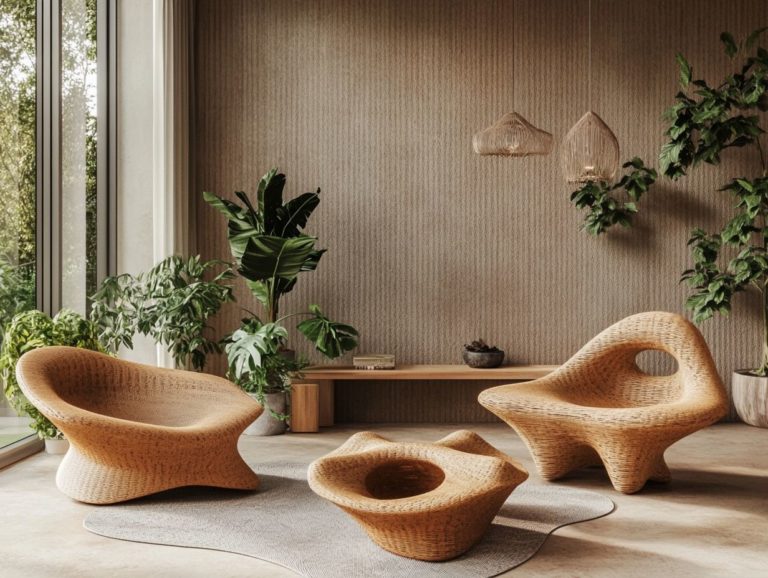The Role of 3D Printing in Modern Interior Design
3D printing is changing how we approach interior design. It blends creativity with functionality in exciting ways.
This technology enhances customization and efficiency while supporting sustainability. It reshapes traditional design practices remarkably.
Discover the benefits of 3D printing today and its transformative impact on the industry, as it integrates effortlessly into your design projects.
We will also delve into the challenges you might encounter when adopting this technique. Get ready to explore the future of interior design through the exciting lens of 3D printing.
Contents
- Key Takeaways:
- The Advantages of Using 3D Printing in Interior Design
- How 3D Printing is Transforming the Interior Design Industry
- Integrating 3D Printing into Interior Design Projects
- Potential Challenges and Limitations of 3D Printing in Interior Design
- Frequently Asked Questions
- What is the role of 3D printing in modern interior design?
- How does 3D printing impact the design process?
- Can 3D printing be used to create functional interior design pieces?
- In what ways does 3D printing benefit interior designers?
- Are there any limitations to using 3D printing in interior design?
- Can 3D printing be used for sustainable interior design?
Key Takeaways:
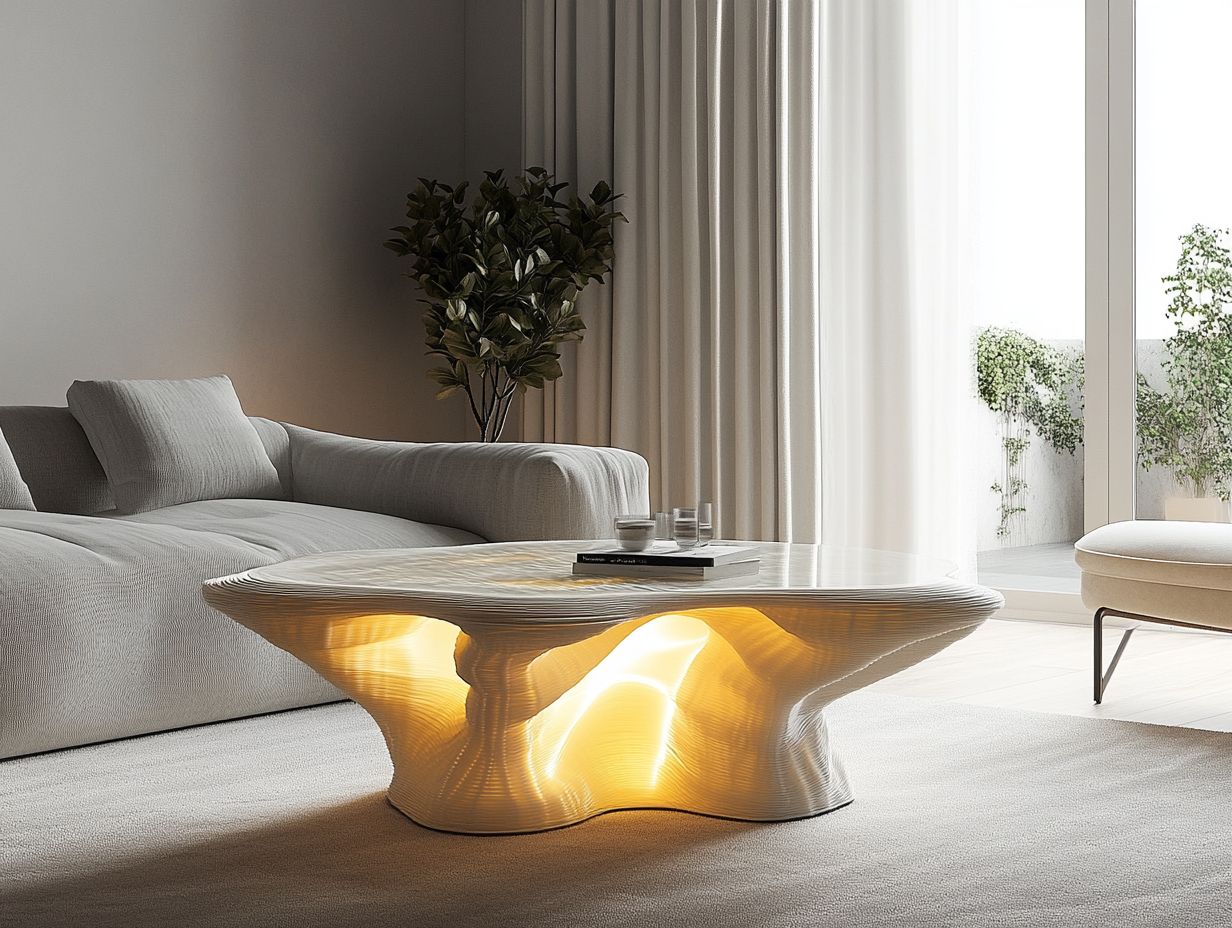
- Efficiency and customization are key advantages of 3D printing in modern interior design.
- 3D printing is cost-effective, sustainable, and offers innovative design possibilities.
- Collaboration with architects and designers is crucial for successful integration of 3D printing.
What is 3D Printing?
3D printing, often referred to as additive manufacturing, is a groundbreaking technology that transforms digital data into tangible physical structures. This remarkable capability allows you, as a designer or architect, to explore unparalleled design freedom and unleash your creativity.
Not only does this innovative process enhance architectural design, but it also opens up new avenues for customization and rapid prototyping. With 3D printing, creating complex geometries and artistic designs that were once beyond reach in traditional manufacturing becomes a reality.
The roots of this technology trace back to the early 1980s when Charles Hull developed Stereolithography, a method that employs ultraviolet light to solidify liquid resin layer by layer. Carl Deckard later introduced Selective Laser Sintering, which builds components by fusing powdered materials with a high-powered laser.
These pivotal processes illustrate how 3D printing functions by gradually layering materials to construct intricate shapes. Today, the applications of 3D printing are vast, extending across industries such as aerospace, healthcare, and particularly in architectural and furniture design.
Here, customized pieces and complex structures can be swiftly realized, significantly cutting down time and costs during the design phase.
The Advantages of Using 3D Printing in Interior Design
Integrating 3D printing into your interior design practices brings a wealth of advantages that elevate the entire design process. This technology allows for great customization and supports sustainability initiatives, helping to reduce environmental concerns linked to traditional manufacturing methods.
By harnessing cutting-edge technology, you can craft unique, bespoke pieces tailored specifically to your clients’ preferences, fostering creativity and innovation in every project you undertake.
Efficiency and Customization
Efficiency and customization stand out as two remarkable advantages of 3D printing technology, enabling you to prototype and iterate designs far more rapidly than traditional manufacturing ever could.
This innovative method accelerates your production timeline and grants you an unparalleled level of design flexibility and personalization that caters directly to your clients’ specific needs.
As a result, 3D printing creates an environment where your creative ideas can come to life swiftly, addressing unique client specifications with ease.
Take furniture design, for example; you can leverage this technology to craft bespoke pieces think intricately patterned chairs and tables that fit seamlessly within a client’s space and reflect their style.
Notable projects showcase the potential of 3D printing, such as stunning lines of modular furniture that adapt to various living environments. This demonstrates how customization can elevate both functionality and interior aesthetics.
This ability to deliver distinct, tailored designs at a rapid pace not only satisfies modern consumer demands but also highlights the transformative power of 3D printing across design disciplines.
Cost-effectiveness and Sustainability
Cost-effectiveness and sustainability have become paramount in interior design. 3D printing emerges as a standout solution that adeptly addresses both concerns. By utilizing recycled materials and significantly minimizing waste during the manufacturing process, this technology not only lowers production costs but also fits well with today’s eco-friendly trends. This makes it an appealing choice for both designers and consumers.
By optimizing material usage, 3D printing reduces the need for raw resources, which not only trims costs but also shrinks the environmental footprint typically associated with traditional manufacturing. The rapid turnaround time this technique offers means you can bring your concepts to life quickly, ultimately speeding up project timelines and boosting overall efficiency.
The use of sustainable materials, such as bio-based plastics, highlights a strong commitment to green practices within the industry. As 3D printing continues to advance, its influence on the interior design landscape looks promising, paving the way for innovative and environmentally friendly design solutions.
How 3D Printing is Transforming the Interior Design Industry
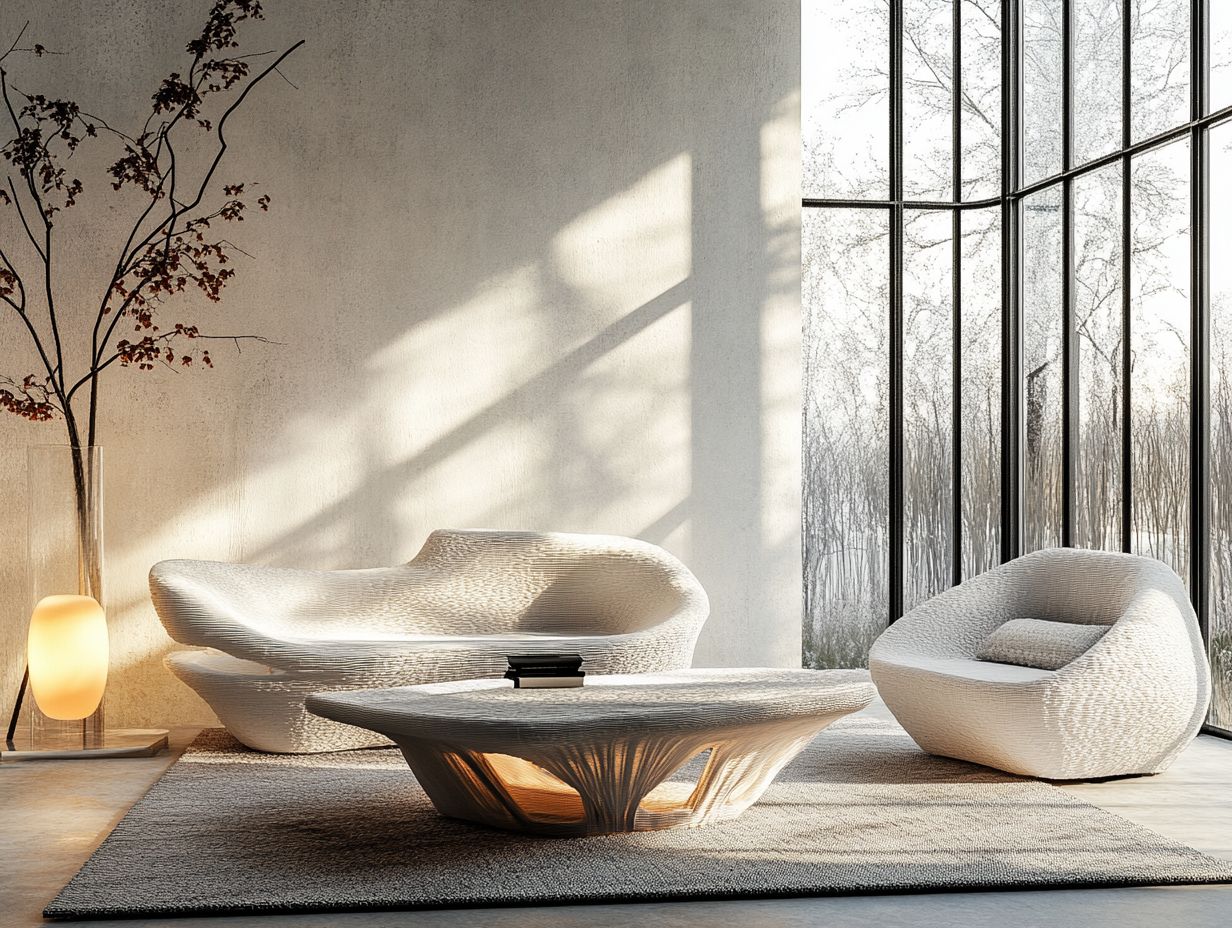
3D printing is transforming the interior design industry in remarkable ways, introducing innovative projects that harness digital fabrication techniques using computers to create physical objects. This evolution is reshaping traditional manufacturing processes and propelling design toward more imaginative and efficient solutions.
This shift enhances the look of interior spaces while empowering you, as a designer, to explore the limits of creativity in your work.
Unleash Your Creativity with 3D Printing!
The design possibilities brought about by 3D printing technology empower you to create unique artistic designs and intricate architectural finishes that were once out of reach with conventional manufacturing methods. This capability broadens the scope of furniture design and encourages a wider range of creative expressions within interior spaces.
Imagine being able to produce complex geometric patterns resulting in stunning wall architraves and bespoke light fixtures. These do more than just serve functional purposes they also become captivating focal points. You can now experiment with materials such as biodegradable plastics and metals, paving the way for eco-friendly solutions that resonate with contemporary values.
These innovations challenge traditional notions of craftsmanship and ignite new styles and aesthetics in interior design, transforming each space into a unique narrative of artistry and vision.
Streamlined Production Process
3D printing revolutionizes the production process, allowing greater design flexibility while significantly reducing your time-to-market. This adoption of advanced technology simplifies the creation of complex designs and contributes to a more efficient workflow in your interior design projects.
By leveraging rapid prototyping, you can quickly iterate on your concepts, testing various materials and forms without the burden of expensive production runs. For example, consider a New York-based interior design firm that successfully utilized 3D printing to craft custom furniture pieces perfectly aligned with their clients’ visions. Clients had the opportunity to see and feel prototypes before making final decisions, allowing for quick adjustments that transformed the entire design experience.
These case studies illustrate how integrating 3D printing can significantly enhance both creativity and practicality in the design industry, ultimately leading to delightful outcomes for both you and your clients.
Integrating 3D Printing into Interior Design Projects
Integrating 3D printing into your interior design projects demands a thoughtful approach that fosters collaboration between architects and designers. You must carefully select materials to enhance both design customization and functionality.
This synergy ensures that your final outcomes not only boast aesthetic appeal but also meet practical considerations seamlessly.
Collaboration with Architects and Designers
Collaboration between architects and designers is essential when implementing 3D printing in interior design projects. This partnership sparks new ideas by leveraging the unique strengths of both disciplines.
Such teamwork enhances your creative process and leads to efficient workflows and impactful design results.
By merging architectural expertise with design creativity, you can explore the full potential of 3D printing technologies. This results in designs that may have previously seemed unfeasible. For instance, a renowned architectural firm collaborated with a startup specializing in 3D printing technology, yielding the iconic house of the future a striking showcase of sustainable materials and customizable layouts.
In the fashion industry, similar partnerships have given rise to groundbreaking wearables that seamlessly blend technology with aesthetics. This redefines what apparel design can be.
These examples illustrate how interdisciplinary collaboration not only ignites fresh ideas but also propels innovation within the 3D printing landscape, underscoring a dynamic and ever-evolving industry.
Choosing the Right Materials and Techniques
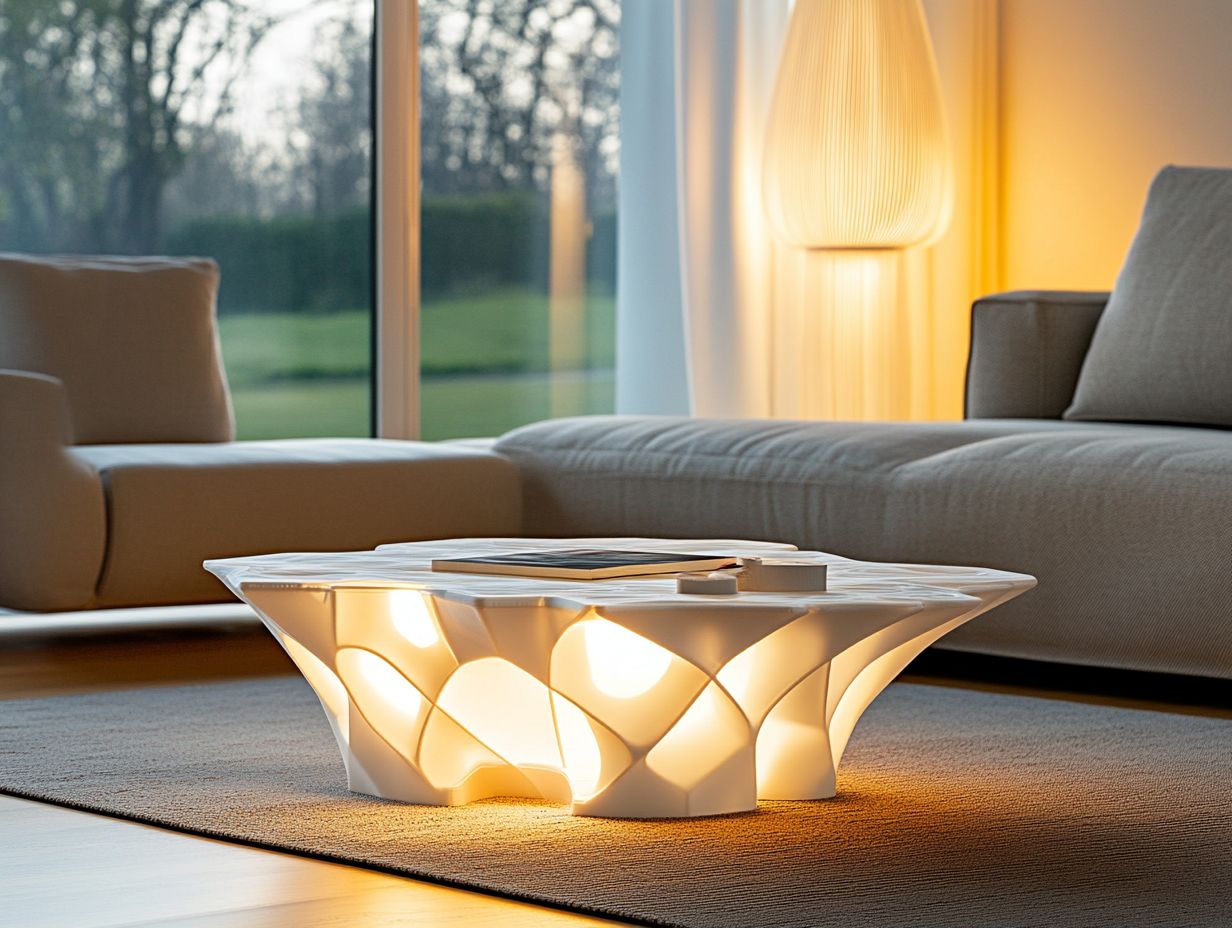
Choosing the right materials and techniques for your 3D printing endeavors is key to unlocking your project s potential. This decision ultimately influences both the durability and aesthetic quality of your final product.
As you navigate the selection process, you’ll evaluate various materials, from photosensitive resin to recycled options, each offering its unique properties and benefits.
For instance, thermoplastics like PLA and ABS are favored for their strength and ease of use. They are ideal choices for functional prototypes or decorative elements. On the other hand, stronger materials like nylon provide enhanced structural integrity for more demanding applications.
Metal printing opens up an entirely different realm, enabling intricate designs that traditional materials might struggle to support. This expands your creative possibilities.
Each material presents distinct advantages, affecting everything from the weight of your object to the level of detail you can achieve. Therefore, making informed choices is vital for meeting client expectations and adhering to project timelines.
Potential Challenges and Limitations of 3D Printing in Interior Design
While 3D printing offers numerous advantages in interior design, you may encounter challenges and limitations along the way. Technical constraints and the steep learning curve associated with adopting this innovative technology can pose serious challenges.
These obstacles might hinder the broader implementation of transformative capabilities. You, as a designer or architect, must navigate uncharted territory while adapting your practices to fully harness the potential of 3D printing.
Technical Constraints and Learning Curve
The technical constraints of 3D printing technology, coupled with the steep learning curve, present serious challenges to your adoption of this innovative tool in interior design. You ll need to familiarize yourself with various software and equipment, which can be quite a challenge in terms of time and resources.
This often means investing not only in the 3D printers themselves but also in advanced design software that allows you to create models ready for printing. A solid understanding of computer-aided design software is essential, as this knowledge can extend your learning phase, adding complexity to what might initially seem like a straightforward process.
Troubleshooting hardware issues and calibrating printers for optimal performance can easily sidetrack your timelines, leading to increased costs and potential project overruns. Therefore, recognizing these hurdles is vital for crafting realistic project plans and ensuring your outcomes are successful.
Impact on Traditional Manufacturing and Labor
The rise of 3D printing is set to significantly reshape traditional manufacturing and labor practices within the interior design industry, leading to changes toward more sustainable and efficient production processes. This transformation raises important questions about the future role of labor in manufacturing and the environmental impact of reducing waste during production.
As innovative techniques replace older methods, industries may be on the brink of a profound disruption, potentially leading to job displacement for those skilled in conventional manufacturing practices. This shift opens doors for adaptation and upskilling, fostering a workforce that is better equipped for the evolving technology.
Beyond workforce implications, 3D printing presents substantial environmental advantages by minimizing material waste and enabling localized production, significantly reducing transportation emissions. By embracing this cutting-edge technology, your firm can enhance operational efficiencies while contributing to a more sustainable future for our planet.
Frequently Asked Questions
What is the role of 3D printing in modern interior design?
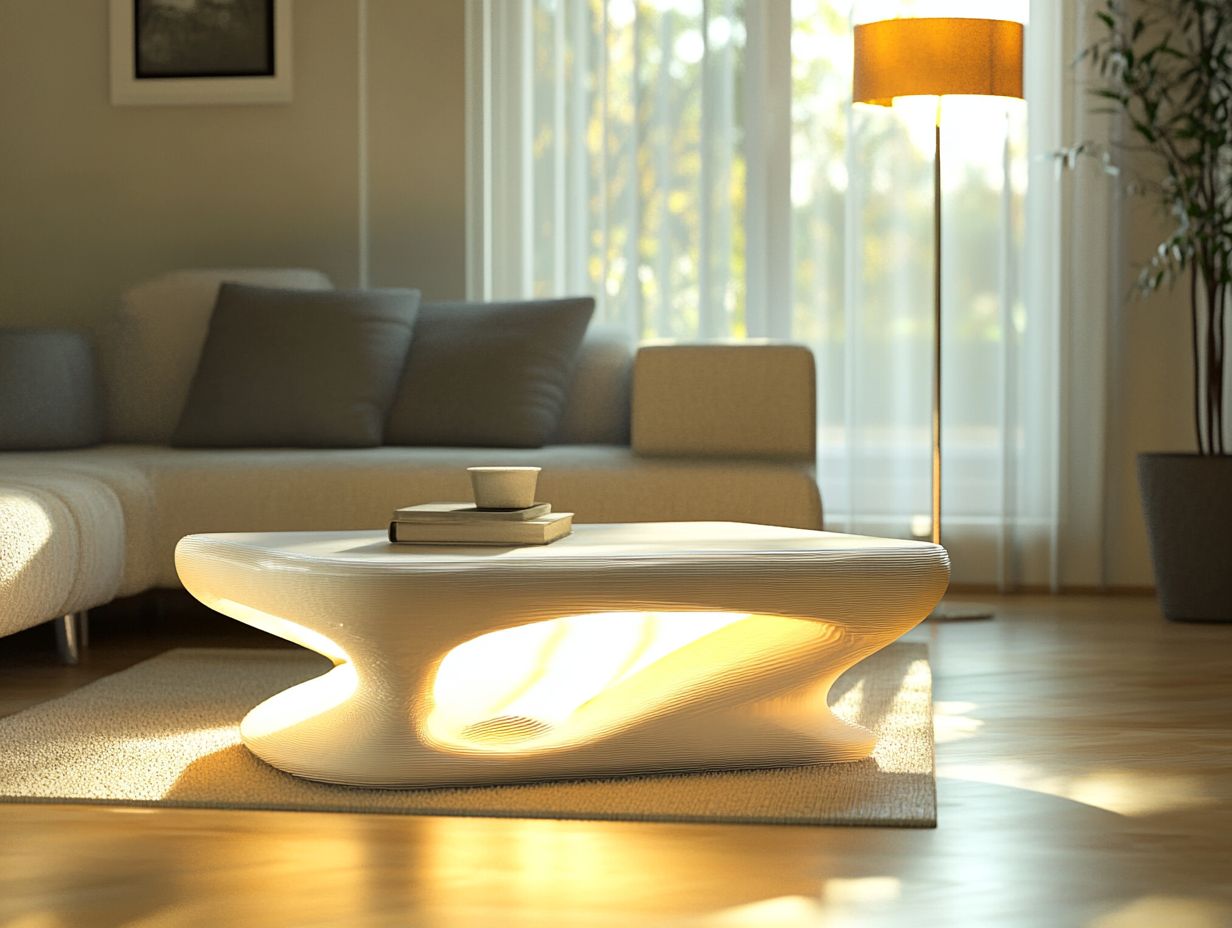
3D printing plays a crucial role in modern interior design as it allows for the creation of custom and unique pieces that cannot be produced through traditional manufacturing methods, highlighting the role of 3D-printed furniture in sustainable living.
How does 3D printing impact the design process?
3D printing allows for faster prototyping and iteration in the design process, leading to more efficient and creative designs. It also enables more complex and intricate designs to be brought to life.
Can 3D printing be used to create functional interior design pieces?
Yes, 3D printing can be used to create functional pieces such as furniture, lighting fixtures, and home decor. With advancements in materials, 3D printed pieces can be just as durable and functional as traditionally manufactured ones.
In what ways does 3D printing benefit interior designers?
3D printing allows for more creative freedom and flexibility in design, reduces production time and costs, and enables the production of one-of-a-kind pieces that can set designers apart in the industry.
Are there any limitations to using 3D printing in interior design?
While 3D printing offers many benefits, there are limitations to consider. The size of the printer can restrict the size of the final product, and some materials may not be suitable for certain designs. Additionally, the initial investment in a 3D printer and materials can be costly for small businesses or independent designers.
Can 3D printing be used for sustainable interior design?
Yes, 3D printing can contribute to sustainable interior design by reducing waste and using more eco-friendly materials. With the ability to create precise and custom pieces, 3D printing can help reduce the need for mass production and overconsumption of resources.

